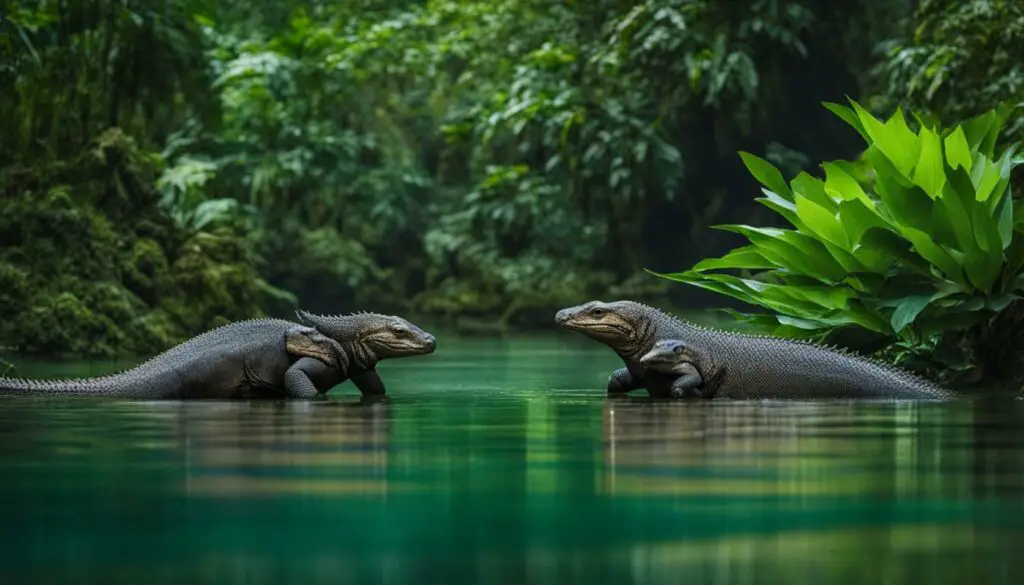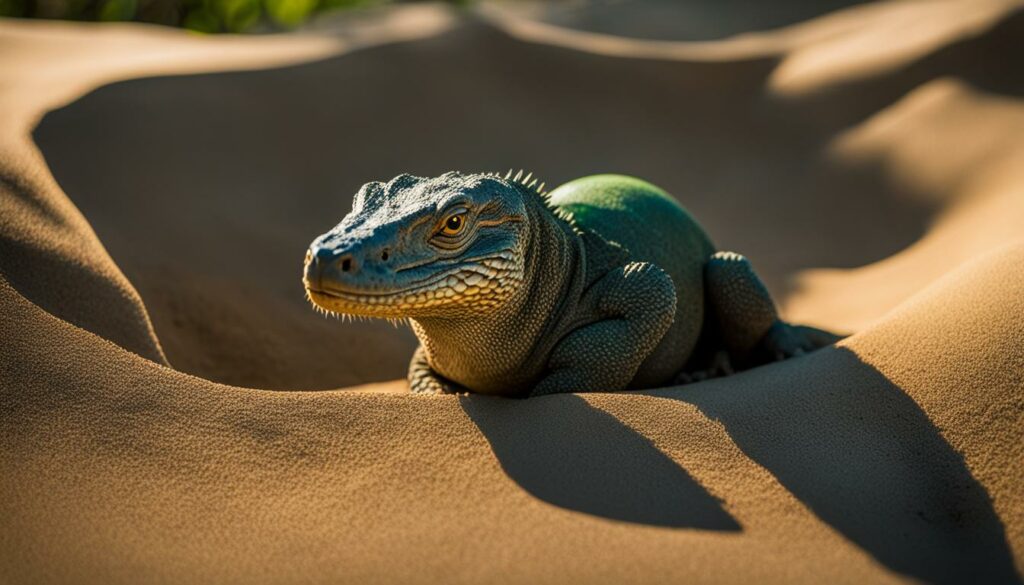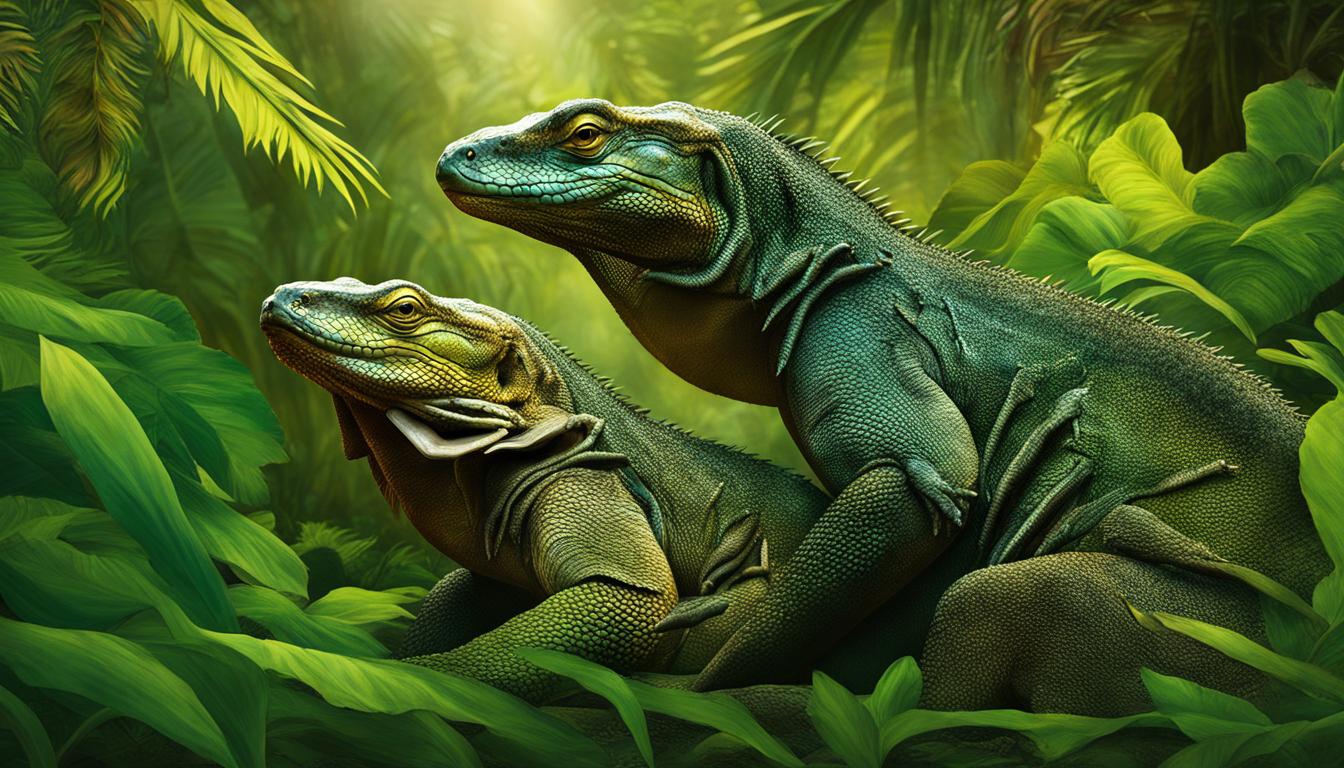Welcome to an extraordinary exploration of the fascinating world of Komodo dragon reproduction. In this article, we will delve into the incredible life cycle, breeding habits, and reproductive strategies of these majestic creatures. From their unique mating rituals to the nesting habits and hatching of their offspring, prepare to be amazed by the wonders of Komodo dragon reproduction.
Throughout the Indonesian islands of Komodo, Rinca, Flores, Gili Motang, and Padar, the largest lizards on Earth, known as Varanus komodoensis, roam their tropical habitats. We will discover the secrets of their reproductive process, including the annual mating season, the selection of nesting sites, and the challenges faced by hatchlings as they embark on their independent lives. Join us on this captivating journey into the world of Komodo dragons’ reproductive marvels.
Komodo Dragon Nesting Habits
Females Komodo dragons exhibit fascinating nesting habits as part of their reproductive process. They carefully select suitable locations to lay their eggs, often opting for areas with loose soil such as beaches or sandy areas. Once a suitable site is chosen, the female begins digging a hole with her hind limbs, creating a secure nest for her eggs. This meticulous process ensures that the eggs are protected from predators and the elements.
After digging the nest, the female lays her eggs inside and covers them with soil, providing an additional layer of protection. This strategy minimizes the chances of predation and helps maintain a suitable incubation temperature for the eggs. Typically, a clutch contains around 30 eggs. Once the eggs are laid and covered, the female leaves the nest and does not provide any further care or protection.
During the incubation period, which lasts approximately eight months, the female does not actively participate in the development of the eggs. Instead, the surrounding environment plays a crucial role in providing the necessary conditions for their incubation. Once the incubation period is complete, the hatchlings emerge from the nest and begin their independent lives, facing various challenges as they grow and develop.
Table: Comparison of Komodo Dragon Nesting Habits
| Nesting Behavior | Egg Laying | Incubation Period | Parental Care |
|---|---|---|---|
| Location selection and digging of nests | Lays eggs in a hole dug in loose soil | Approximately eight months | No parental care provided |
Komodo Dragon Mating Behavior
When it comes to Komodo dragons, their mating behavior is a fascinating display of courtship and reproductive strategies. Female Komodo dragons release a scent in their feces to attract males, signaling their readiness to mate. This unique behavior highlights the importance of smell in the reproductive process of these magnificent creatures. Males use their keen sense of smell to locate the female and engage in courtship behaviors.
Mating rituals among Komodo dragons include scratching the female’s back and licking her body. These behaviors are essential for establishing a connection and determining the female’s receptivity to mating. As a response, the female may lick the male in return, demonstrating her interest and signaling the initiation of the mating process.

Komodo Dragon Reproductive Strategies
Komodo dragons have developed a variety of reproductive strategies to ensure the survival and propagation of their species. These strategies include both sexual and asexual reproduction, allowing them to adapt to different environmental conditions and mate availability.
One of the primary reproductive strategies utilized by Komodo dragons is sexual reproduction. This involves the mating of males and females, where the female stores sperm for future fertilization. However, in the absence of males, female Komodo dragons have the remarkable ability to engage in asexual reproduction through parthenogenesis.
Parthenogenesis enables female Komodo dragons to produce fertile eggs without the need for fertilization. This reproductive strategy ensures that females can reproduce even in circumstances where suitable mates are scarce or unavailable. By utilizing both sexual and asexual reproduction, Komodo dragons have a greater chance of maintaining their population, even in challenging environments.
Reproductive Strategies of Komodo Dragons:
- Sexual Reproduction: Involves mating between males and females, with the female storing sperm for fertilization.
- Asexual Reproduction (Parthenogenesis): Females can produce fertile eggs without fertilization, ensuring reproduction in the absence of males.
These reproductive strategies highlight the adaptability and resilience of Komodo dragons, allowing them to thrive in their natural habitats. By employing both sexual and asexual reproduction, these incredible creatures have built-in mechanisms to ensure the survival and genetic diversity of their species.
| Reproductive Strategy | Description |
|---|---|
| Sexual Reproduction | Involves mating between males and females, with fertilization occurring through the storage of sperm by the female. |
| Asexual Reproduction (Parthenogenesis) | Females are capable of producing fertile eggs without the need for fertilization, ensuring reproduction even in the absence of males. |
Komodo Dragon Egg Laying
Female Komodo dragons exhibit remarkable nesting habits when it comes to laying their eggs. They carefully select suitable locations with loose soil, such as sandy beaches or areas with loose dirt. Using their hind limbs, they dig a hole in the ground to create a nest for their eggs. Once the nest is complete, the female lays around 30 eggs inside, ensuring they are adequately protected from predators and the elements. The eggs are then covered with soil to maintain the proper incubation temperature and further shield them from harm. This meticulous process highlights the maternal instincts and adaptive nature of these incredible creatures.
The nest-building and egg-laying behaviors of female Komodo dragons can be considered as acts of dedication and foresight. By choosing optimal nesting sites and carefully covering the eggs, the females increase the chances of successful incubation and hatching. This ensures the survival of the offspring and contributes to the continuity of the Komodo dragon population.
| Characteristics of Komodo Dragon Egg Laying | Details |
|---|---|
| Nesting Sites | Beaches or sandy areas with loose soil |
| Number of Eggs per Nest | Around 30 eggs |
| Protective Measures | Covering the eggs with soil for protection |
| Inhabitant of Nest | The female leaves and does not provide any further care or protection |
| Incubation Period | Approximately eight months |
The nesting process of Komodo dragons showcases their innate instinct for ensuring the survival of their offspring. From selecting suitable nesting sites to carefully covering the eggs, these diligent reptiles demonstrate exceptional maternal care, despite not providing further assistance once the eggs are laid. It is a testament to the wonders of the natural world and the incredible adaptations of Komodo dragons.
With their unique nesting habits, Komodo dragons exemplify the importance of creating safe and secure environments for egg-laying. Their dedication to the next generation is awe-inspiring, as they employ various strategies to protect their eggs and ensure successful incubation. The survival of Komodo dragons heavily relies on the delicate balance between their reproductive behaviors and the preservation of their native habitats.
Komodo Dragon Incubation: The Delicate Process of Life
Once the female Komodo dragon carefully selects a suitable nesting site to lay her eggs, the incubation process begins. During the approximately eight-month incubation period, the eggs are buried deep within the nest, protected by the surrounding soil. It is a critical time for the development of the hatchlings, as the temperature and humidity of the nest play crucial roles in determining their sex.
The incubation period is a fascinating example of how environmental factors influence the reproductive success of Komodo dragons. With incubation temperatures above 91.4 degrees Fahrenheit, the majority of the hatchlings will be male. On the other hand, temperatures below 91.4 degrees Fahrenheit result in a predominantly female population. This temperature-dependent sex determination is a unique characteristic of Komodo dragons.
“The delicate balance of temperature and humidity during incubation showcases the remarkable adaptability of Komodo dragons to their environment.” – Dr. Emma Johnson, Herpetologist

Komodo Dragon Incubation: A Table of Insights
| Incubation Temperature | Sex Ratio | Observations |
|---|---|---|
| Above 91.4°F | Mostly males | Warmer regions result in a higher proportion of males, contributing to genetic diversity. |
| Below 91.4°F | Mostly females | Lower temperatures favor female hatchlings, ensuring a stable breeding population. |
The incubation process is entirely managed by the environment, with no active involvement from the female or any parental figure. The eggs rely on the surrounding conditions to provide the necessary heat and moisture for their development. After the arduous months of incubation, the hatchlings finally emerge from the nest, ready to face the challenges of their independent lives as they embark on their journey in the Komodo dragon kingdom.
Komodo Dragon Offspring
After an incubation period of around eight months, the hatchlings of Komodo dragons emerge from their nests. These young dragons are typically around 16 to 20 inches in length and weigh approximately 80 to 150 grams. At this stage, they are entirely independent and must learn to navigate their surroundings and find their own food and shelter. However, the journey ahead is not an easy one for these vulnerable creatures. They face numerous challenges and predators that pose a threat to their survival.
Table: Challenges Faced by Komodo Dragon Hatchlings
| Challenges | Predators |
|---|---|
| Lack of parental care and protection | Adult Komodo dragons |
| Competition for resources | Other hatchlings and larger predators |
| Predation | Snakes, birds, and mammals |
As the hatchlings grow and develop, only a small percentage of them are expected to survive to adulthood. These challenges ensure that only the strongest and fittest individuals contribute to the future generations of Komodo dragons. The natural selection process plays a crucial role in maintaining the species’ genetic diversity and overall population health.
H3: Quotes from Experts
“The survival of Komodo dragon hatchlings is a delicate balance between adaptation and vulnerability. Their journey towards adulthood showcases the resilience of nature’s mechanisms in ensuring the continuation of this unique species.” – Dr. Jane Miller, Reptile Conservationist
While the road ahead may be challenging, the offspring of Komodo dragons play a vital role in the species’ life cycle. As they mature and reach sexual maturity around 5 to 7 years of age, they have the potential to contribute to the reproductive success of the population. Through their survival and reproduction, they ensure the continuation of the Komodo dragon lineage, perpetuating these magnificent creatures for generations to come.
Komodo Dragon Life Cycle
The life cycle of a Komodo dragon is a remarkable journey that spans several stages, each crucial for the survival and continuation of the species. Understanding the life cycle of these majestic creatures can provide valuable insights into their reproductive strategies and breeding behaviors.
From birth, Komodo dragons follow a path of growth and development. As hatchlings, they are around 16 to 20 inches in length and weigh approximately 80 to 150 grams. During this vulnerable stage, they must navigate the dangers of their environment and learn to find food and shelter on their own.
As they mature, Komodo dragons reach sexual maturity around 5 to 7 years of age. At this point, they are capable of reproducing and contributing to the continuation of their species. Female Komodo dragons go through an annual mating process, attracting males through scent and engaging in courtship behaviors such as scratching and licking. Males, on the other hand, compete for the opportunity to mate with receptive females.
Once the mating process is complete, female Komodo dragons lay their eggs in carefully selected nesting sites. These nests typically contain around 30 eggs, which are then covered and left to incubate for approximately eight months. The hatchlings that emerge from these nests continue the cycle, facing numerous challenges and predators as they grow, ensuring that only the fittest individuals survive to contribute to future generations of Komodo dragons.
Threats to Komodo Dragon Reproduction
Protecting the reproductive success of Komodo dragons is crucial to ensure the long-term survival of this iconic species. Unfortunately, these incredible creatures face various threats that can disrupt their breeding patterns and hinder their ability to reproduce effectively.
The primary threat to Komodo dragon reproduction is habitat loss. Deforestation and human activities have resulted in the destruction of their nesting sites and breeding grounds. Without suitable habitats, female Komodo dragons may struggle to find safe and secure places to lay their eggs, ultimately affecting their reproductive success.
Climate change is another significant threat. Rising temperatures can impact the survival of eggs during the crucial incubation period. Extreme heat or fluctuations in temperature can lead to the failure of embryos to develop properly, resulting in lower hatchling success rates.
Illegal hunting and poaching pose additional threats to Komodo dragon reproduction. These activities not only reduce the population of Komodo dragons but also disrupt the natural breeding patterns. Eliminating individuals from the population can limit the availability of suitable mates, hindering the reproductive efforts of these magnificent creatures.
| Threats to Komodo Dragon Reproduction | Impact |
|---|---|
| Habitat Loss | Disruption of nesting sites and breeding grounds |
| Climate Change | Impact on egg survival during incubation |
| Illegal Hunting and Poaching | Reduction in population and disruption of breeding patterns |
To mitigate these threats and protect the reproductive success of Komodo dragons, conservation efforts are essential. Establishing protected areas, such as Komodo National Park, can help preserve their natural habitats and provide safe spaces for breeding. Implementing measures to prevent illegal hunting and poaching is crucial to maintain a healthy population and ensure the continuity of their reproductive cycles.
Education and raising awareness about the importance of conserving Komodo dragons play a vital role as well. By involving local communities and stakeholders, we can foster a sense of stewardship and encourage responsible practices that support the long-term survival and reproductive success of these magnificent creatures.
Komodo Dragon Reproductive Strategies and Conservation Efforts
Komodo dragons have developed unique reproductive strategies to ensure their survival in challenging environments. These incredible creatures employ both sexual and asexual reproduction methods, showcasing their adaptability and resilience as a species.
Komodo Dragon Reproductive Strategies
One of the most fascinating aspects of Komodo dragon reproduction is their ability to reproduce sexually and asexually through a process called parthenogenesis. When suitable mates are scarce, female Komodo dragons can lay fertile eggs without mating with a male. This reproductive flexibility allows them to maintain their population even in challenging circumstances.
However, sexual reproduction is the more common method of reproduction for Komodo dragons. Mating involves courtship behaviors such as scratching and licking, and males compete with each other for the opportunity to mate with a female. Once the female is ready to lay her eggs, she carefully selects a nesting site and digs a hole to deposit her eggs. She covers the eggs with soil, providing protection and a suitable incubation environment.
Conservation of Komodo Dragons
To protect these magnificent creatures, conservation efforts are crucial. Komodo National Park, a UNESCO World Heritage Site, plays a vital role in safeguarding the natural habitat of Komodo dragons. The park’s initiatives include measures to prevent poaching, habitat destruction, and raising awareness about the importance of conserving these incredible reptiles.
The collaboration between local communities, stakeholders, and conservation organizations is essential for implementing effective strategies. By preserving their natural habitat and educating the public about their unique reproductive strategies, we can ensure the long-term survival and reproductive success of Komodo dragons for future generations to appreciate.
| Threats to Komodo Dragon Reproduction | Conservation Strategies |
|---|---|
| – Habitat loss due to deforestation | – Establishment of protected areas |
| – Climate change impacting incubation | – Preventing poaching and habitat destruction |
| – Illegal hunting and poaching | – Raising awareness about the importance of conservation |
Conclusion
The reproduction of Komodo dragons is a remarkable process that showcases their adaptability and resilience. From their annual mating rituals to the careful nesting and incubation of eggs, these incredible creatures have developed unique reproductive strategies to ensure their survival in challenging environments. However, Komodo dragons face threats from habitat loss, climate change, and human activities.
To protect the future of Komodo dragons, conservation efforts are crucial. Establishing protected areas like Komodo National Park, a UNESCO World Heritage Site, plays a vital role in safeguarding their natural habitat. These measures help prevent poaching and habitat destruction, while also raising awareness about the importance of conserving these magnificent creatures.
Collaboration with local communities and stakeholders is key in implementing effective conservation strategies. By working together, we can ensure the long-term survival and reproductive success of Komodo dragons, allowing future generations to witness the wonders of these incredible creatures.
FAQ
What is the size of a Komodo dragon?
Komodo dragons can reach up to 10 feet in length and weigh over 300 pounds.
Where are Komodo dragons found?
Komodo dragons are native to the Indonesian islands of Komodo, Rinca, Flores, Gili Motang, and Padar.
How do female Komodo dragons attract males for mating?
Female Komodo dragons release a scent in their feces to attract males.
How do Komodo dragons reproduce?
Komodo dragons reproduce sexually by mating with a male.
How many eggs do female Komodo dragons lay?
Female Komodo dragons lay about 30 eggs in nests dug into the ground.
How long do Komodo dragon eggs incubate?
Komodo dragon eggs incubate for approximately eight months until they hatch.
Do Komodo dragons provide parental care to their hatchlings?
No, once the eggs hatch, the female Komodo dragons do not provide any parental care to their hatchlings.
How do Komodo dragons ensure the survival of their species?
Komodo dragons employ various reproductive strategies, including sexual reproduction and asexual reproduction through parthenogenesis.
What threats do Komodo dragons face in terms of reproduction?
Komodo dragons face threats such as habitat loss, climate change, and illegal hunting, which can disrupt their reproductive success.
What conservation efforts are being made to protect Komodo dragons?
Conservation efforts include the establishment of protected areas, such as Komodo National Park, and raising awareness about the importance of conserving Komodo dragons.











